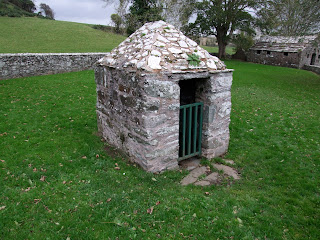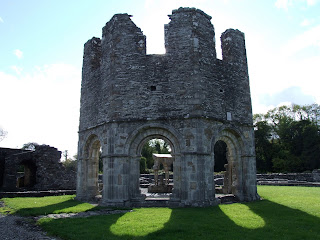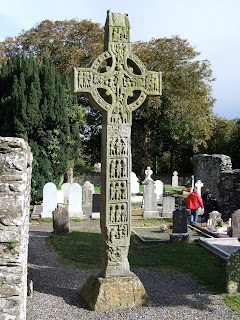Saul parish church
Mearne Well has to be one of the most peculiar wells that I have ever visited and yet also one of the best kept. The best place to start is in the small Church of Ireland parish of Saul, said to be one of the earliest sites of a Christian church in Ireland. Saint Patrick is supposed to have landed in Ireland in an area close to here and in 432AD he built a wooden barn for the people to meet in and worship. Saint Patrick is said to have spent four years here, preaching and teaching and establishing a Christian community which would later - despite numerous vicious Viking raids – become a monastic settlement and later an Augustinian abbey which functioned up until the period of the dissolution.
The interior of the church
The legend of Saint Patrick’s arrival in Saul is slightly more colourful. He is said to have arrived on a hired boat on the nearby River Slaney. As he travelled up the river a local pagan chieftain named Dichu spotted him and he followed the boat with his dogs to see where the saint would land. As soon as Saint Patrick set his foot to the riverbank, Dichu set his hungry hounds upon him, but Saint Patrick is said to have been able to close the mouths of the hungry beasts and Dichu being mightily impressed, immediately converted.
The church viewed from the graveyard
Tales of how Patrick overcame danger or displayed great power are very common in the lore regarding the life of the saint. In some ways this lore has a literary purpose and it uses the imagery of the Old Testament in particular to make its point. In some instances Patrick’s power is made to echo the life and activity of Elijah - the prophet who comes before the Messiah. In this instance the story echoes Daniel in the lion’s den – possibly an allusion to the fact that Patrick refused to have any part in the pagan prayers and rituals of the people he came into contact with.
The 'Mortuary' house in the graveyard
Saul church is no longer a simple wooden barn, but neither is it a grand abbey. After the dissolution of the monasteries a church was re-erected from the rubble in 1788. Unfortunately the church was so poorly built that it had to be demolished and the parish had to wait until 1933 for its current building to be finished. In some ways it is a pastiche of a vague Celtic style, but it’s pleasant and inside it is really quite beautiful even though it is very small. Above the tiny altar in a plain sanctuary of typical Celtic sobriety is a copy of the magnificent window of Saint Patrick by Catherine O’Brien – she seems to pop up a lot on this blog!
The prayer room
Before you even get to the church, you walk down a very fine avenue lined by trees and into the left is a small outhouse where you can drop in a pray and make various prayer requests on a large map pinned to the wall beside an early carved stone cross grave marker. It’s a quiet place in a peaceful spot and whoever had this idea really should be commended for it. There are so few places that allow for this type of thing and so few churches that would be prepared to take the risk of leaving the church and the room open. Outside in the graveyard there is a small stone structure said to be Saint Patrick’s bed. It has also been classed as an old mortuary house (seems to be rather small for that and may have been a confusion with what is now the prayer room), the grave of Saint Patrick himself (very unlikely), the grave of an abbot or cleric or other forgotten saint or a dried up well. From here you can look across to Slieve Patrick - a pilgrim route to the top of a hill where a huge stone statue of Saint Patrick was erected in 1932.
The path to Mearne well
Leaving the church, the holy well said to have been blessed by Patrick himself for the baptism of the first few of his converts to Christianity in Ireland, is down the hill towards the town of Downpatrick. About halfway down the hill, quite literally in the middle of someone’s garden is the well. Access to the well is from the road by a narrow cobbled path to a reasonably large square well housing. There are a number of ballaun stones that have been placed here, possibly brought down from the church site.
One of the many ballaun stones at Mearne well
Ballaun stones are thought to be either grain grinding stones or stones to grind out pigment. It is more likely that they are stones to grind out pigment and it is therefore of no surprise that they are found in close association to ancient religious sites and settlements. In some cases they may also be the bases of what have been called ‘cursing stones’ (the actual stone for turning having gone missing). These were stones that were turned anti-clockwise to enact a curse on someone. In early Christianity in Ireland, there are stories of the saints bringing these items to the religious sites to ‘Christianize’ them. Although these saints were unable to completely rid the area of such items, they did manage to halt their frequent use and rid the people of dark superstition that was often destructive to society and community living. In some cases there are stories that the saints told people that they could use the cursing stones, but if they were used incorrectly that the curse would fall upon them and it would fall even more powerfully. This all but rendered the cursing stones impotent of their perceived power and gradually they fell out of use. In rare circumstances the stones were preserved, engraved with a cross and used to turn clockwise three times invoking the Trinity in order to bless someone.
The well
Saint Patrick’s well (often called Mearne well) is very beautifully kept, but it is so difficult to get away from the fact that while at the well and trying hard to reflect on the significance of this site, you are all the time directly under the living room window of someone’s private property. It is a little peculiar, but if you manage to turn off the part of your brain that tells you that you might be trespassing on private land, here seems as good as place as any to pray for those who will also - in the tradition of Saint Patrick - be preparing for baptism in their own church. Here too, remember your own baptism, which in likelihood if you are from this island can be traced back to this very spot, and pray too for the healing of community life; for deliverance from vain and idle strife that can be so damaging to society and community.
Keep us, O Lord, from the vain strife of words, and grant us a constant profession of our faith. Preserve us in the way of truth, so that we may ever hold fast that which we professed when we were baptized into the name of the Father, and of the Son and of the Holy Ghost, and may give glory to thee, our Creator, Redeemer and Sanctifier, now and evermore.
Amen.
Saint Hilary of Poitiers.
How to find it:
Saul parish church is well signposted from Downpatrick. As you leave the parish church main entrance, turn right down the hill and take the first left. About half way down this hill you will see a few houses on the left with a millstone and a few other large rocks at the entrance to the driveways. Mearne well is only slightly further up the hill from this point and is accessed directly from the road and there is a path cut into the middle of someones front garden!









































